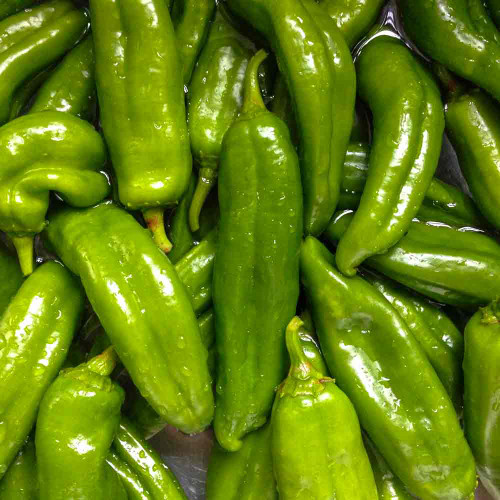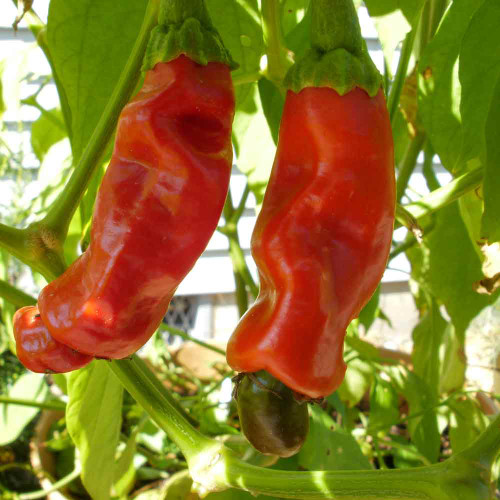Description
Chilhuacle Negro - Emperor of Chiles
This rare chile seed took us years to track down. Our search wound through a network of friends, farmers, and market vendors in Oaxaca, eventually leading us to a photographer who knew the esteemed cookbook author Susanna Trilling. Through her expertise, we finally sourced the authentic seeds, which led us to a mutual friend who grows for Rick Bayless, the renowned chef specializing in traditional Mexican cuisine. After careful cultivation, we're thrilled to offer this extraordinary pepper to our fellow gardening enthusiasts.
The Chilhuacle Negro pepper perfectly embodies Winston Churchill's famous phrase, "a riddle, wrapped in a mystery, inside an enigma." This dark chocolate brown chile, ancient even when the Aztecs discovered it, is the cornerstone ingredient in the revered mole negro dish and fundamental to the quintessential seven moles of Oaxaca, Mexico. Chilhuacle (pronounced she-WA-clee) or chile huacle comes from the Nahuatl word chilli, meaning "chile," and huactli, meaning "old." With its strong notes of cocoa, tobacco, and dry fruit, followed by a chocolate and sweet raisin aftertaste, this rare chile is worth growing and discovering in your garden.
Mole (pronounced MO-lay) describes a family of sauces in Mexican cuisine and is considered one of the most important dishes in Mexico. The word mole originates from the Nahuatl word molli, meaning "sauce."
Even in ancient times, the Chilhuacle Negro was rare, elusive, and expensive, as documented by Susana Trilling in her groundbreaking 1999 cookbook, Seasons of My Heart: A Culinary Journey Through Oaxaca, Mexico. Beginning in the late 1990s, a series of hurricanes, tropical storms, pests, and fungal attacks devastated chilhuacle crops, significantly reducing yields and forcing many growers to abandon their fields. However, the story doesn't end there.
Today, a handful of dedicated growers in the Oaxaca area are working to keep this and other ancient chiles alive. Several prominent chefs across Mexico have partnered with these growers to sustain and increase production. Since 2014, biologists at Mexico's National Institute of Forestry, Agriculture, and Livestock Research have been developing innovative methods to cultivate chilhuacle under cover, protecting the plants from pests and diseases. This rarity has made it one of the most expensive chiles in Mexico. In 2012, Oaxacan-grown chilhuacle negro was $500 per kilo in Mexico, and today it is offered at $1200 per kilo.
This chile seed has taken years for us to obtain—our authentic seed stock was finally secured through a mutual friend who is a grower for Rick Bayless, the Chicago-based, Michelin-starred, and James Beard award-winning chef specializing in traditional Mexican cuisine. It has taken years to grow out enough to sell.
Details
The chilhuacle plant is bushy, reaching 24–30 inches tall, with sturdy, straight stems and dark green oval leaves that complement its delicate white flowers. Its extensive root system can reach depths of 27–47 inches, with most roots concentrated between 2–15 inches deep, effectively seeking moisture in the soil. Individual flowers emerge from the fork of the branches, with each branch bearing 5–6 or more blooms. The fruit itself is moderately hot and blocky, with smooth skin that transitions from a vibrant green to a deep, attractive brown, often bordering on black, as it matures. The interior reveals a deep purple hue.
The chiles maintain their original shape and do not wrinkle as they dry. Left on the plant until it takes on a leathery texture, the fruit is then harvested for final drying, a process that imparts the deep, rich, signature flavor these chiles are known for. Traditionally, the peppers are laid out on rocky hillsides under direct sunlight after harvesting, further contributing to their unique flavor characteristics. The Chilhuacle Negro has a moderate heat level, registering 1,200 to 2,000 Scoville Heat Units (SHU). This moderate heat level makes it appealing to those who enjoy mild to medium spiciness.
History
The earliest history of the Chilhuacle chile is shrouded in mystery, as the region's oral histories were lost when the Aztecs established their empire in the early 1300s. However, we do know that the Aztecs recognized the antiquity of the chilhuacle chiles—the black (chilhuacle negro), red (chilhuacle rojo), and yellow (chilhuacle amarillo)—when they first encountered them. This suggests that these chiles were already considered ancient by the early 1300s.
We can learn more about the chile's history by exploring the evolution of mole, the sauce made from it. In Nahuatl, the language of the Aztecs, this sauce was known as mōlli, meaning "sauce," or chīlmōlli, specifically for chile sauce. Indigenous groups of Northern Oaxaca have traditionally prepared this sauce. In this region, the chilhuacle chile is primarily used for religious ceremonies and festivals, such as the Day of the Dead, celebrations for patron saints, Christmas and New Year's, and family events like weddings and birthdays.
The first written account of molli sauces comes from Friar Bernardino de Sahagún's book, General History of the Things of New Spain, also known as the Florentine Codex. Completed in 1575–1577 in Mexico City after nearly 30 years of research and translation, the book eventually reached the Laurentian Library in Florence, Italy. In 1818, José María Murguía y Galardi, the first governor of Oaxaca, specifically mentioned the chilhuacle as a spice used in stews, served at funeral events, and used as a dye for sauces.
Uses
The Chilhuacle Negro chile is a kitchen alchemist, prized for its versatility in both fresh and dried forms. The Oaxacan people consider it the region's most important chile, a cornerstone of their gastronomy. When vine-dried and ground into a powder, its aroma and flavor become intensely fruity, redolent of molasses and raisins. This powder can be used to flavor soups, sauces, eggs, or any dish where its complex notes will awaken your taste buds.
Perhaps the most iconic use of the Chilhuacle Negro is in Mole Negro, a complex and flavorful Oaxacan sauce where this chile truly shines. Its smoky-sweet notes, reminiscent of raisins and chocolate, intertwine with other ingredients to create a symphony of flavors that defines Oaxacan cuisine. But the Chilhuacle Negro's talents don't end there. Whether fresh or dried, it adds depth and complexity to a variety of salsas and sauces, enhancing both traditional Mexican recipes and modern culinary creations. Fresh Chilhuacle Negro peppers are essential components of classic Oaxacan dishes like Chile Caldo and Chile Relleno, showcasing their versatility.
Truly, the Chilhuacle Negro is a chile that deserves to be explored and savored. Its rich history, unique flavor profile, and culinary versatility make it a treasure of Oaxacan cuisine and a delightful addition to any kitchen.
Growing Tip
Chilhuacles grow best in well-drained, slightly alkaline, deep sandy loam soils, but will grow well in other fertile soil. If suitable soil is not available, a reasonable substitute can be made by mixing 1/3 parts well-composted cow or horse manure, local soil, and fine sand. Mix thoroughly and layer to a depth of 12-15”.
Traditionally the seeds are sown by hand broadcasting and covered using a broomstick. Most American gardeners will have the best success with starting seeds inside, just like other chiles.
Harvest Tip
As mentioned above, the deepest and richest flavor comes from letting the fruit fully mature and start to dry on the plant before harvesting, then finish drying in the sun.
If rains are expected before the fruit are fully mature, simply pull the entire plants up and hang them in a dry area with good ventilation until the fruit are leathery, then harvest as usual.
Learn More
- Growing Peppers 101
- Chile and Pepper Growing Tips
- Grow Better Peppers with Shade
- Fermented Pepper Sauce
- Fermented Chile Paste
From the soil to the seed to the food you eat - we'll help you grow your best garden!



















